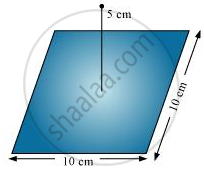Advertisements
Advertisements
Question
A thin conducting spherical shell of radius R has charge Q spread uniformly over its surface. Using Gauss’s law, derive an expression for an electric field at a point outside the shell.
Solution
According to Gauss law,
`epsi_0EointdA=q`
Where,
q is the point charge
E is electric field due to the point charge
dA is a small area on the Gaussian surface at any distance and
`epsi_0` is the proportionality constant
For a spherical shell at distance r from the point charge, the integral `ointdA` is merely the sum of all differential of dA on the sphere.
Therefore, `oint dA =4pir^2`
`epsi_0E(4pir^2) = q`
or `,E = q/(epsi4pir^2)`
Therefore, for a thin conducting spherical shell of radius R and charge Q, spread uniformly over its surface, the electric field at any point outside the shell is
`E = Q/(e_0 4pir^2)`
Where r is the distance of the point from the centre of the shell.
`E = q/(4piepsi_0r^2)`
APPEARS IN
RELATED QUESTIONS
A point charge +10 μC is a distance 5 cm directly above the centre of a square of side 10 cm, as shown in the Figure. What is the magnitude of the electric flux through the square? (Hint: Think of the square as one face of a cube with edge 10 cm.)

A charge Q is placed at the centre of a cube. Find the flux of the electric field through the six surfaces of the cube.
State Gauss’s law for magnetism. Explain its significance.
State Gauss's law in electrostatics. Show, with the help of a suitable example along with the figure, that the outward flux due to a point charge 'q'. in vacuum within a closed surface, is independent of its size or shape and is given by `q/ε_0`
q1, q2, q3 and q4 are point charges located at points as shown in the figure and S is a spherical gaussian surface of radius R. Which of the following is true according to the Gauss' law?

The surface considered for Gauss’s law is called ______.
Five charges q1, q2, q3, q4, and q5 are fixed at their positions as shown in figure. S is a Gaussian surface. The Gauss’s law is given by `oint_s E.ds = q/ε_0`
Which of the following statements is correct?
An arbitrary surface encloses a dipole. What is the electric flux through this surface?
In finding the electric field using Gauss law the formula `|vec"E"| = "q"_"enc"/(epsilon_0|"A"|)` is applicable. In the formula ε0 is permittivity of free space, A is the area of Gaussian surface and qenc is charge enclosed by the Gaussian surface. This equation can be used in which of the following situation?
